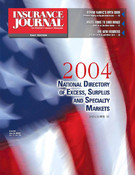Retired police officers Ed and Nancy McCue are thinking about leaving their dream home near the shores of Biscayne Bay because it’s in a prime area for hurricanes.
It’s not the storm threat itself that’s pushing them out, but soaring insurance costs—$1,000 a year for a homeowners policy and an additional $2,100 for windstorm coverage, a bill that has tripled in the last five years.
“I’ve worked really hard to rebuild this community,” Nancy McCue said from the $150,000 home she and her husband rebuilt after the devastation of Hurricane Andrew in 1992. “But this is one of the factors that is driving people out.”
Homeowners are paying increasingly higher insurance rates as more people flock to the coasts and insurers try to cut back on the billions of dollars of losses they’ve absorbed from previous storms. Many residents in high-risk areas, like the McCues, have to buy separate hurricane or windstorm insurance on top of their regular homeowners policies.
Florida’s homeowners insurance rates have increased more than 150 percent since the 165-mph Andrew, which caused $31 billion in damage and stands as the costliest natural disaster in U.S. history. Texas’ average premiums are up about 75 percent and Louisiana’s have risen around 50 percent since then, according to state estimates.
Sharon Ryan, of Jamaica Beach, Texas, pays about $6,000 a year for insurance on two homes on stilts on Galveston Island about a mile from the Gulf of Mexico.
“It’s beyond your comprehension, the insurance costs here,” Ryan said. “It’s just funny, because people come down here and retire and you think you’d have a job to just pay the insurance and the taxes.”
On North Carolina’s Outer Banks, Dahl Clark has watched about a dozen nearby houses crushed by storms the past few years. During last year’s Hurricane Isabel, he was lucky. His 2,300-square-foot Kitty Hawk home was elevated enough to avoid getting wiped out. But he lost a ground-floor refrigerator and water heater—damage he didn’t even report for fear it would cause yet another increase in his $2,000 insurance bill.
“It’s shot up a lot in the last four or five years,” Clark said. “I think the insurance is a big issue, especially for retired folks down here, and there’s a lot of them.”
Insurance industry officials say higher premiums are necessary to keep insurers from going belly up when a destructive storm hits.
Bob Hartwig, of the Insurance Information Institute, said computer forecasts and the practice of insurance companies buying reinsurance have made the industry better prepared. But he said a major hurricane could still bankrupt smaller insurers.
Florida accounted for about half of all insurance losses due to hurricanes in the 20th century, the highest of any state, according to a study cited by the institute. Texas came in second with about 21.4 percent of losses; Louisiana was next with 6.8 percent.
But Florida was only the third most expensive state in which to insure a home in 2000, after No. 1 Texas and Louisiana, according to the latest average premium data from the National Association of Insurance Commissioners. That’s because homeowners insurance normally includes coverage for fire, hail, tornadoes and other catastrophes. Texas is the most expensive because it’s in “Tornado Alley” and it has been hit by billions of dollars in mold claims recently, Hartwig said.
In most Atlantic and Gulf Coast states, homes in coastal areas may be dropped by standard insurers and homeowners are forced to get policies from insurers that offer windstorm insurance specifically for hurricane and wind damage. In Florida, the average annual windstorm premium has risen more than 200 percent over the past decade to reach $1,445 this year. In Texas, windstorm rates have gone up just 30 percent over the last decade to hit an annual average of $574.
Insurers say those rates reflect Florida’s geography as a peninsula with so much coastal land. The development of multimillion dollar buildings along Florida’s beaches also contributes to those spiraling costs.
Consumer advocates say homeowners in certain areas are overcharged because the paths of hurricanes are so unpredictable and they could strike anywhere along the thousands of miles of Atlantic and Gulf Coast.
“The idea of insurance is to spread the risk, not to isolate it,” said Bill Newton, executive director of the Florida Consumer Action Network, a watchdog group.
One homeowner on Mississippi’s Gulf Coast, Dale Buchanan of Belle Fontaine Beach, said he pays about $2,800 a year for insurance, several times the state’s average. He said understands the insurers’ side of the issue, adding that his company helped him after Hurricane Georges in 1998.
“They’re in business to make money and that’s hard to do when you’re getting hit with big losses,” Buchanan said. “I don’t really hold that against them; I just wish they would spread it out a little more evenly.”
Also, soaring property prices in the current real estate boom mean many people insured their homes for much lesser values years earlier. So if a storm wipes them out, they might not be able to afford to buy another house in the area.
Another shock homeowners may get is that many insurers have been changing the way they charge deductibles for hurricane damage. In the past, homeowners had to pay a set dollar amount for a deductible. But after Andrew bankrupted many insurers, they started changing policies so people would have to pay a percentage, usually around 2 percent, of the total damage as their deductible.
Associated Press reporters Mark Babineck in Houston and Emery Dalesio contributed to this report.
Topics Florida Catastrophe Carriers Natural Disasters Texas Louisiana Hurricane Homeowners
Was this article valuable?
Here are more articles you may enjoy.


 California Chiropractor Sentenced to 54 Years for $150M Workers’ Comp Scheme
California Chiropractor Sentenced to 54 Years for $150M Workers’ Comp Scheme  Insurers Norfolk & Dedham of Massachusetts and Union Mutual of Vermont to Affiliate
Insurers Norfolk & Dedham of Massachusetts and Union Mutual of Vermont to Affiliate  Former MLB Player, 3 Others Charged with Staging Auto Accident in Miami
Former MLB Player, 3 Others Charged with Staging Auto Accident in Miami  Soaring Insurance Costs Hit as US Buyers Finally Get a Break on Car Prices
Soaring Insurance Costs Hit as US Buyers Finally Get a Break on Car Prices 


